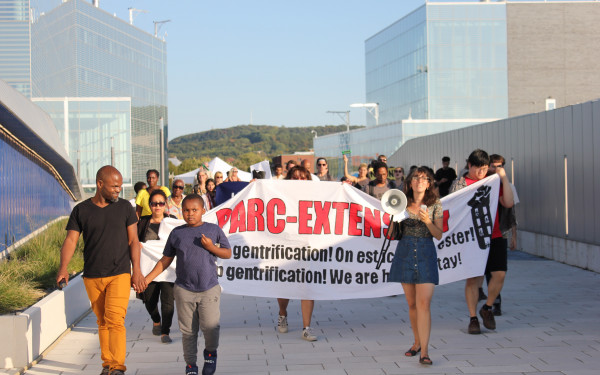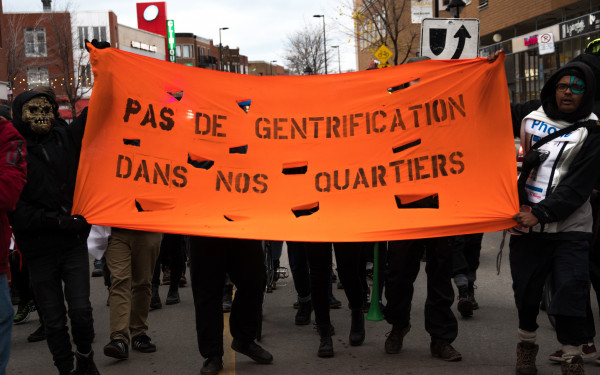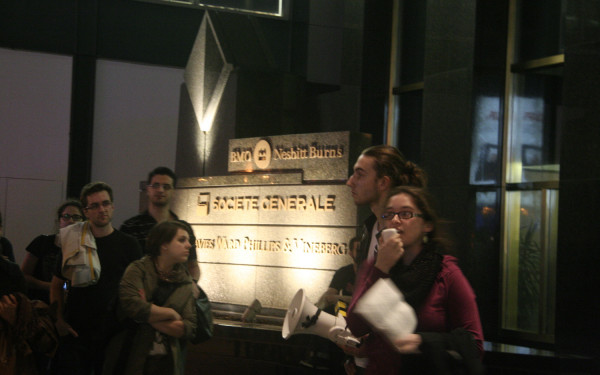Protesters March Notre-Dame Street to Push Back Against Gentrification
Collective pushes for Free Communal Space in St. Henri
Tailed by a fleet of police cars, around 40 people marched along Notre-Dame St. on the afternoon of Oct. 29 protesting the gentrification sweeping Saint-Henri, and demanding a vacant building to repurpose into an autonomous space for the neighbourhood.
“We’re calling for a space to develop into a hub where people can be social and interact outside their homes,” said Mona Luxion, spokesperson for the Collective for Autonomous Space, the group behind the demo. “Which at this time is increasingly hard to do as prices continue to rise in restaurants, cafes and shops along the major streets in St. Henri.”
“Today is also an opportunity for us to show the support this project has in the neighbourhood, and to make the project more visible,” they added.
The troupe made sure they were visible that afternoon, leaving Station Lionel-Groulx just before 3 p.m.—with one person dressed as Donald Trump, another as a clown and all the protesters were singing and chanting.
Along Notre-Dame St., the procession halted traffic and its cacophony drew the scrutiny of police and onlookers. Faces peeked out from behind doorways, diners at Tacos Victor gawked and customers at cafés stopped mid-cappuccino to stand on stoops and watch the hodgepodge parade pass by.
At Sir George-Étienne Cartier Square, a small marching band materialised, adding a trumpet, trombone and saxophone to the din. The demo transformed from protest to parade: whistles blew, music blared and marchers jived, “On lâche rien,” they sang—or “We don’t give up”—which is from a song by French band, HK et Les Saltimbanks.
Fred Burrill, who lives in the neighbourhood, stopped the group in the middle of the street to speak, his voice echoing over speakerphone in front of boutique grocery, Trente Sept Trente Quatre. In May, around 30 masked vigilantes stormed the store, looting food and vandalizing the storefront with graffiti.
An anonymous communique, released following the attack and purportedly written by the group, claims the stolen food was redistributed in the neighbourhood in the days that followed.
“The media want to talk a lot about violence in that context, but for us the question is ‘what is the real violence?’ The violence of gentrification, the violence of displacement,” said Burrill. “We consider the people who live in the neighbourhood to be worth a lot more than some sausages.”
The march continued and stopped again, this time in front of Notorious Barbershop where store employees opened their door and exchanged shouts with protesters.
“The barbershop is one of the first of many luxury businesses to open in the neighbourhood,” explained Burrill. “It created this little locus of well-off people who are living out a playground lifestyle in the midst of a neighbourhood where half the people—in St. Henri—live below the poverty line.”
The demo ended in front of the original St. Henri public library—now an abandoned building on the corner of Courcelle St. and Notre-Dame St. The protesters hope to turn this building into a social center.
A wall of police pushed protesters back from occupying the building, and they erected a tent outside instead, all the while continuing to play music under the gaze of more than a dozen police officers. Cuisine Populaire, a collective kitchen in St. Henri, waved away the afternoons wind chill with bowls of warm chili made from corn, carrots and red beans.
Going forth, spokesperson Luxion said the Collective for Autonomous Space would continue to speak with the borough.
“We’re going to continue those negotiations, and we’re going to continue to mobilise at a door-to-door, popular level,” they said. “We hope to get one the vacant buildings on Notre-Dame converted into a space as soon as possible.”

_900_522_90.jpg)
_600_832_s.png)

1_600_375_90_s_c1.jpg)


